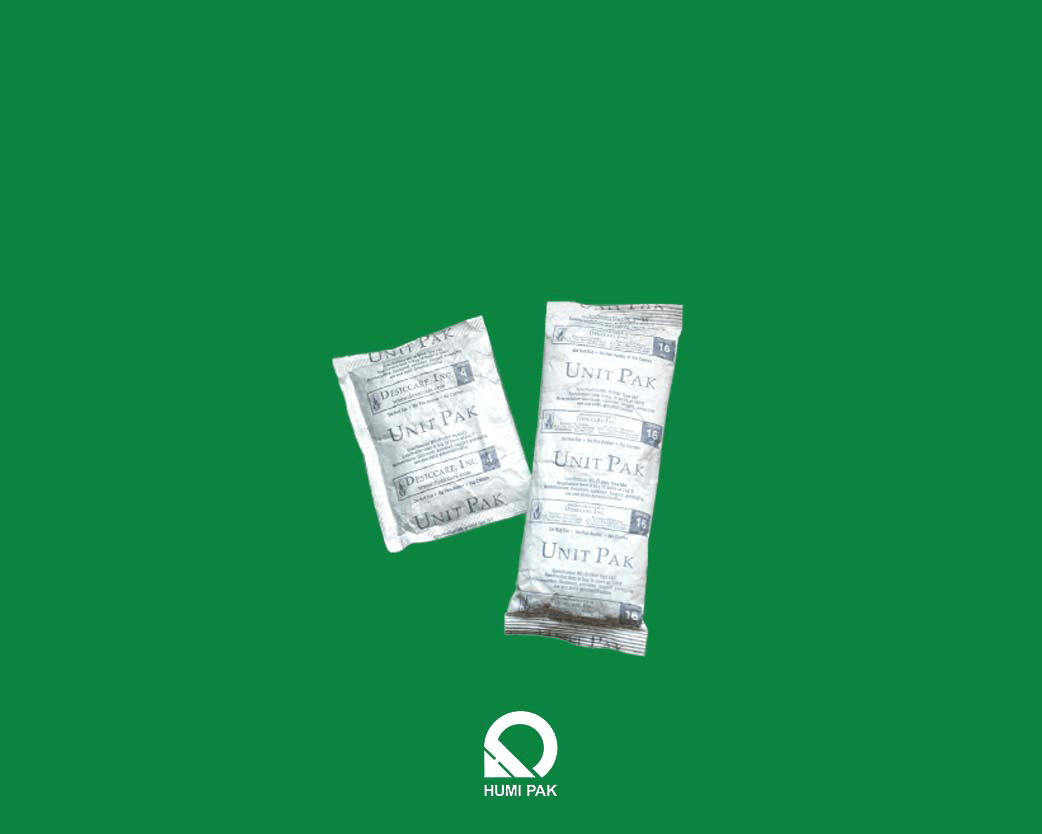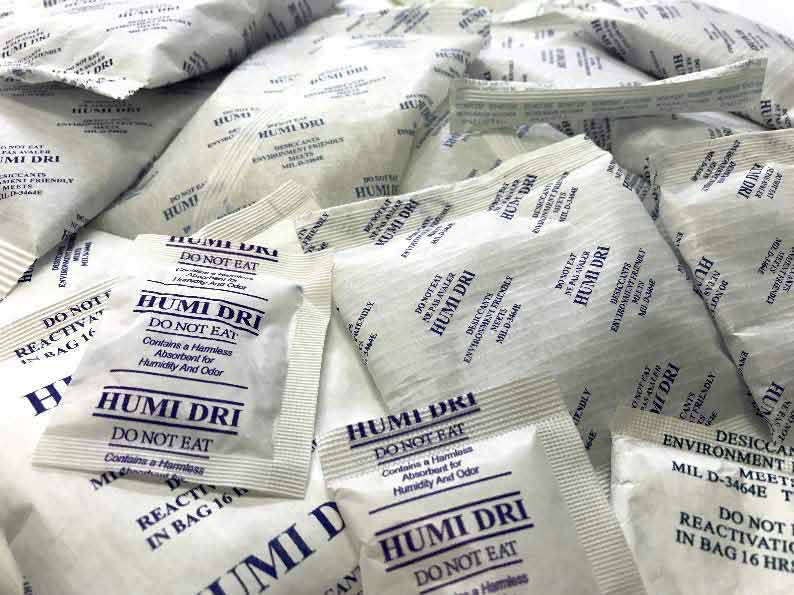How Much Desiccants To Use?

Desiccants are essential components in packaging, designed specifically to absorb moisture and prevent potential product damage. Their significance spans industries, from pharmaceuticals, where even slight moisture can affect medicine quality, to electronics, where damp conditions might cause malfunctions.
However, it’s not just about having desiccants; it’s about using the right quantity. Overuse leads to unnecessary costs, and underuse risks product integrity. This article will guide readers in determining the optimal amount of desiccant needed for different packaging scenarios.
Understanding Desiccants
Desiccants are specifically designed to absorb and retain moisture from their surrounding environment. Their primary function is to establish a state of dryness in the immediate vicinity, making them suitable for various industries to prevent moisture-related damage.
They operate on the principle of seeking equilibrium. When introduced to an environment with high humidity, they pull water molecules toward themselves through adsorption (where moisture adheres to the surface) or absorption (where moisture is integrated into the material). This action persists until the desiccant is saturated or the surrounding environment is sufficiently dry. The efficacy of this process varies based on the type of desiccant, its inherent properties, and the conditions it encounters.
Common Types of Desiccants:
While these are more common, many other bulk desiccants, like activated charcoal, are available, each tailored to specific applications and conditions.
 Silica Gel: Often found in small sachets accompanying packaged goods, silica gel is derived from silicon dioxide. Its porous structure gives it a high capacity for water absorption, making it one of the most widely used desiccants.
Silica Gel: Often found in small sachets accompanying packaged goods, silica gel is derived from silicon dioxide. Its porous structure gives it a high capacity for water absorption, making it one of the most widely used desiccants.- Calcium Chloride: This hygroscopic salt excels at drawing moisture from the air. Because of its ability to hold a significant amount of water relative to its size, it’s frequently used in larger applications, such as in shipping containers.
- Clay Desiccants: Made primarily from bentonite clay, these desiccants are natural, environmentally friendly, and reusable. They’re often used when consistent, moderate moisture absorption is needed over extended periods.
- Molecular Sieves: These synthetic zeolites have uniform pore sizes that can selectively adsorb gases or liquids based on their molecular size. They’re especially effective when a very low humidity level is desired, as they can achieve much lower moisture levels than other desiccants.
Factors Determining the Amount of Desiccant Needed
Considering a few factors holistically ensures that the right desiccant amount is used, striking a balance between product protection and cost efficiency.
Volume and Surface Area of the Container: The size of the container or packaging plays a pivotal role in deciding the quantity of desiccant required. Both the volume and surface area determine the potential space for moisture ingress. A larger container typically demands more desiccant, as it has a more significant volume of air to dehumidify. Simultaneously, a container with a larger surface area might be more prone to moisture penetration, especially if it’s not airtight.
Type of Product Being Packaged: Not all products have the same vulnerability to moisture. Some items, like certain electronics or pharmaceuticals, can be severely affected even by minimal moisture exposure. On the other hand, products like textiles or leather goods might only need protection from extreme dampness.
Expected Storage Conditions: Where and how the product is stored profoundly influences desiccant needs. If the storage environment is inherently humid, or if significant temperature fluctuations could lead to condensation, more desiccant may be necessary. Additionally, the expected duration of storage is a vital consideration; longer storage times typically mean more extended exposure to potential moisture, necessitating more desiccant.
Barrier Properties of the Packaging Material: Not all packaging materials are created equal regarding moisture protection. Some materials, like certain plastics, offer a high barrier against moisture, while others, like paper-based materials, might be more permeable. The choice of packaging material determines its synergy with the desiccant. If the material is more permeable, it may demand more desiccant to compensate.
Desired Moisture Level at the End of Storage: Different products have varying optimal moisture levels to maintain quality and functionality. For instance, preserving pharmaceuticals might necessitate an extremely low moisture environment, whereas food items might only need to avoid extreme dampness. Setting a target moisture level aligned with the product’s needs helps determine the precise desiccant quantity.
Calculating the Right Amount of Desiccant
The precise amount of desiccant needed depends on several variables, but as a starting point, the following general formula can be used:
Desiccant Amount (in grams) = (Volume of the Container in liters) x (Desired Moisture Level)
The “Desired Moisture Level” is usually given in grams of moisture per litre. For instance, when packaging electronics and aiming for a very low moisture level, this might be set to 0.02 grams/litre. This formula provides a rough estimate. Other factors, such as the permeability of the packaging material and expected external conditions, can influence the actual required amount.
Environmental conditions, storage durations, and product changes can all impact the effectiveness of the chosen desiccant quantity. Regularly re-assessing and adjusting desiccant levels ensures optimal protection for products. For example, if desiccant needs were initially calculated for winter storage and then transitioned to humid summer months, an adjustment in the amount might be necessary.
While the basic formulas are handy for a quick estimation, specialized tools can provide more accurate data.
- Hygrometers and Humidity Data Loggers: These tools measure and track humidity levels inside the packaging or storage area, providing real-time data to assess desiccant performance.
- Moisture Analyzer: Particularly useful for industries where even slight moisture changes can be crucial, moisture analyzers give precise moisture content readings in products, allowing for more targeted desiccant use.
Common Mistakes in Using Desiccants
By being aware of common mistakes, better decisions can be made in selecting and applying desiccants, ensuring optimal product protection.
Using Too Much or Too Little: One of the most frequent missteps in desiccant usage is not gauging the necessary amount. Using too much desiccant can lead to unnecessary costs and sometimes even harm certain products by excessively drying the environment. On the flip side, using too little compromises the protective purpose of the desiccant, leaving products vulnerable to moisture damage, mould growth, or other adverse effects.
Choosing the Wrong Type of Desiccant: Each desiccant type has its own set of properties and is best suited for specific applications. For instance, molecular sieves are excellent for achieving extremely low moisture levels, while clay desiccants might be better for general-purpose uses. Utilizing a desiccant ill-suited for the particular requirement can result in subpar moisture control, potentially endangering the product’s quality and shelf-life.
Improper Placement Within the Packaging: Even with the right amount and type of desiccant, its effectiveness can be reduced if not positioned correctly within the package. Desiccants need to be placed where they can efficiently interact with the air inside the packaging. Burying them deep within a product or placing them in a corner where airflow is restricted can hinder their performance. Proper placement ensures maximum exposure to the internal atmosphere, allowing the desiccant to function efficiently.
Conclusion
The effective use of desiccants in packaging hinges on getting the quantity right. Understanding the factors that influence desiccant requirements—ranging from product sensitivity and storage conditions to packaging material—ensures that goods remain protected.
As with any tool, correctly applying desiccants is key to achieving their intended benefits. Humi Pak, a manufacturer based in Malaysia, produces desiccant packs certified under ISO 9001 and ISO 14001 standards. Consult with our packaging engineers to discover how to shield goods from moisture damage using optimal packaging solutions.”


